

Research and Monitoring Initiative (RMI)
VISION STATEMENT
The Research and Monitoring Initiative addresses the need for regional research and monitoring of marine and coastal resources during offshore wind development, construction, operation and decommissioning as recommended in the New Jersey Offshore Wind Strategic Plan. Initial funding is provided by developers through New Jersey’s Offshore Wind Solicitation 2.
This Initiative is a rigorous scientific approach to uphold the State’s mandate to protect and responsibly manage New Jersey’s coastal and marine resources while supporting the State’s Offshore Wind Economic Development Act, Executive Order 8 and Executive Order 92, and the Energy Master Plan, which respond to climate change and protect our environment for future generations.
The Research and Monitoring Initiative (RMI) is administered by the Department of Environmental Protection in collaboration with our partners at the Board of Public Utilities (BPU).
The Initiative seeks to employ a rigorous scientific approach to research and monitoring of marine and coastal resources during the development, construction, operation and decommissioning of offshore wind as recommended in the New Jersey Offshore Wind Strategic Plan.
The goal of the Research and Monitoring Initiative is ensure that as New Jersey moves towards a clean energy economy, we also adhere to our mandate to protect and responsibly manage New Jersey’s coastal & marine resources.
PRINCIPLES
Be transparent in decision-making, with Initiative implementation and funding conducted through continued and open communication with interested and affected parties.
Balance New Jersey’s environmental goals of furthering New Jersey’s renewable energy targets while effectively managing and promoting New Jersey’s natural resources consistent with NJ Department of Environmental Protection and fulfilling NJ Board of Public Utilities statutory mandates and priorities, including:
- Reduce and respond to climate change.
- Manage and promote thriving natural & historic resources.
- Protect New Jersey’s water.
- Promote the development of clean, renewable sources of energy.
- Ensure safe, adequate, and proper utility services at reasonable rates for customers in New Jersey.
- Lower energy costs, reduce demand for electricity, emit fewer pollutants into the air and create jobs.
Further the scientific understanding of existing coastal and marine natural resources, including but not limited to the physical and chemical environment, wildlife, fisheries, and any changes, whether beneficial or detrimental, to those resources resulting from offshore wind development, construction, operations and decommissioning.
Produce credible, scientifically rigorous data, analysis, and reporting that can be used for identifying, understanding, avoiding, minimizing, and/or mitigating impacts from offshore wind on marine resources, as well as evaluating efficacy of mitigation efforts.
Objectives
Establish an adaptable framework for future offshore wind research and monitoring efforts, including goals, objectives, protocols, criteria for prioritization of projects, roles and responsibilities, and timeframes.
Consult, partner with, and maintain effective communication with existing regional offshore wind and wildlife/fisheries groups to identify research priorities and timeline for products.
Maintain communication and coordination between conservation organizations and state and federal agencies.
Keep stakeholders informed about all RMI activities consistent with Roles and Responsibilities for RMI. Facilitate coordination of scientific research and monitoring activities between RMI awardees and NY Bight leaseholders in the waters off of New Jersey’s coastline.
Contribute to the greater regional research effort by ensuring that existing and ongoing research is leveraged such that research tasks are not duplicative, data gaps are addressed, and the long-term monitoring needs are met.
Conduct rigorous, hypothesis-based, and scientifically defensible monitoring and research with results that are reproducible and statistically robust.
Identify and inform actions for adaptive management to avoid, minimize, and/or mitigate impacts, including cumulative impacts, from offshore wind on coastal and marine resources, including habitat, biota, and recreational and commercial fisheries.
Identify future offshore wind research needs related to coastal and marine resources as they relate to the Initiative; and
The RMI research agenda will be executed in phases. Because of the importance of characterizing existing environmental and ecological conditions, the RMI is currently focused on gathering pre-construction data. This first phase of the RMI will begin in the Spring of 2022 and last approximately two years.
 Phased Research Agenda
Phased Research Agenda
The RMI Team identified a list of research and monitoring priorities for New Jersey based on our current understanding of resources of concern, data gaps, and information needs, which was informed by an extensive literature review, interactions with analogous groups throughout the mid-Atlantic, and engagement with relevant stakeholders. Our understanding is expected to evolve with the continued expansion and coordination of regional research efforts. Read more about the RMI project development process here .
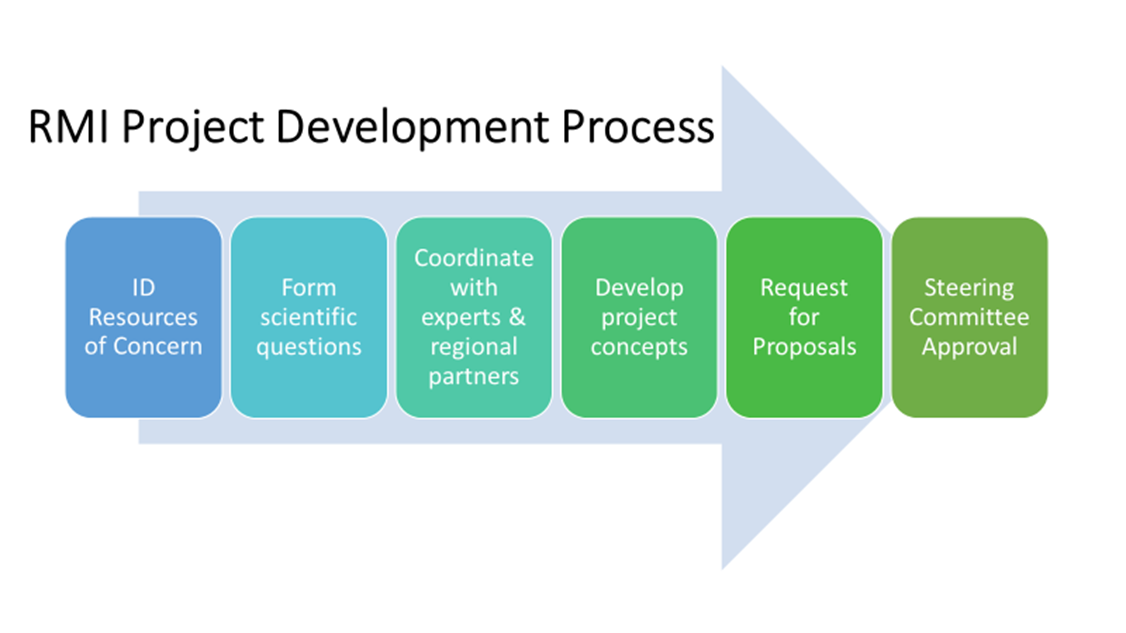 RMI Process photo
RMI Process photo
To identify resources of concern, DEP evaluated data from:
- DEP’s Ecological Baseline Studies
- High-value marine habitats (e.g., CZM Special Areas, mid-Atlantic Cold Pool)
- Mid-Atlantic Data Portal
- Federally & state-managed fisheries
- Literature review
To form the scientific questions that the RMI projects will focus on, the DEP took a impact-oriented approach. DEP asked the following questions:
- Is there convincing evidence that any impact would be negligible?
To answer this question, DEP:- Conducted Literature literature review
- Solicited stakeholder input
- Sought input from local subject matter experts
If no, the next question is: - Is the topic being pursued by other entities?
If yes: DEP is Coordinate coordinating with that entity.
If no, the next question is: - Are the potential impacts to the resource limited to the development project site?
If yes: research into those impacts should be included in developer’s project-specific research and monitoring plans
If no, that topic is suitable for regional research RMI funding.
Below is a table of partners with whom the RMI Team coordinates.
| Organization/Group |
| Bureau of Ocean Energy Management (BOEM) Office of Renewable Energy Programs |
| Coastal States Organization |
| Interstate OSW Fisheries Call |
| Mid-Atlantic Regional Council on the Ocean (MARCO) |
| Mid-Atlantic Committee on the Ocean (MACO) |
| Multi-state Offshore Wind Call |
| NJ Climate Change Alliance (NJCCA - Rutgers University) |
| NOAA Fisheries |
| New York State Energy Research Development Authority (NYSERDA) |
| NYSERDA/NJDEP Research & Monitoring Coordination |
| Regional Wildlife Science Collaborative for Offshore Wind (RWSC) |
| Responsible Offshore Science Alliance (ROSA) |
| Rutgers Center for Ocean Observing Leadership (RUCOOL) |
| US Environmental Protection Agency |
| US Fish & Wildlife Service |
After identifying the Resources of Concern for New Jersey, coordinating with other state, regional, and federal partners to identify data gaps, and developing scientific questions to address those gaps, the RMI team develops a research project concept.
Two mechanisms for funding are available for RMI projects: 1) a competitive process with a traditional Request for Proposals (RFP) or 2) a direct contract with a state university or New Jersey Sea Grant Consortium member.
For the competitive process, a full RFP is developed by the RMI Team and submitted to the Steering Committee for review before posting.
For direct contracts with state universities and NJ Sea Grant members, a full proposal is developed and submitted to the DEP RMI team.
Regardless of the funding mechanism, once vetted and approved by the DEP RMI team, the RFP or full proposal is submitted to the RMI Steering Committee for a vote. The Steering Committee is comprised of three BPU and three DEP representatives. A majority vote of four is required for RFP/project approval.
The RMI expects initial projects to begin during the Spring/Summer 2022 field season. Currently, the focus of the RMI is to collect pre-construction data, to characterize the existing environment. Many of the timing details beyond that are undefined at this point.
| Short-term Highest Priority Research & Monitoring Needs* | ||
| Data Management | 1 | Data standardization, processing, analysis, housing, and QA/QC |
| Environmental Change | 2 | Examine impacts of OSW energy development on seafloor, light conditions, and ocean stratification (i.e., how could potential changes in circulation patterns due to OSW development affect geological and physical oceanographic properties, such as the mid-Atlantic Cold Pool?) |
| Benthos | 3 | Identify & evaluate valuable bottom habitats (e.g., sand ridges, surfclam beds, SAV in estuaries – use survey work in lease areas to identify habitat types) and organisms (summer flounder, skate, dogfish, horseshoe crab, sturgeon); model potential changes to these habitats and organisms |
| Birds | 4 | Develop baseline estimates of population-level distribution information (with focus on Red Knot, Piping Plover, and Roseate Tern) by expanding GPS, Motus, and satellite tag technology to characterize migratory movements – particularly flight altitudes – throughout the NY bight |
| Bats | 5 | Update known population data at the proposed development sites (i.e., how many bats will potentially be interacting within the known lease areas) |
| 6 | Use best available technologies (e.g., nanotags and Motus network) to determine the extent of bat migration/activity offshore in the NY Bight (especially for Hoary, Silver-haired, and Eastern red bats) | |
| Fishes & Invertebrates | 7 | Examine effects of OSW on the distribution/connectivity of fish & invertebrate species and communities (e.g., acoustic tags for horseshoe crabs or species with obligate migration paths) |
| 8 | Examine the distribution and use of habitat by larvae and juveniles (fishes/crustaceans) in the New York Bight (e.g., nursery function and spawning grounds) | |
| Sea Turtles | 9 | Collate existing data for sea turtle movement, distributions, and habitat use patterns; conduct beach surveys where possible (i.e., how do these animals use the space?) |
| Marine Mammals | 10 | Estimate habitat use, distribution, and abundance by season (e.g., overwintering harbor seals) for the right whale, other whales and dolphins through supporting PAM efforts in the NY Bight; identify environmental variables driving these patterns |
| 11 | Evaluate relative threat of mortality/injury to for the right whale, other whales and dolphins from vessel strikes (including increased vessel interactions due to creation of traffic corridors) associated with OSW and non-OSW activities | |
| Fisheries | 12 | Adapt DEP trawl survey design to allow for comparison of biases/limitations in and outside of OSW development areas and calibrate new time series |
| 13 | Identify and implement methods to determine how dredge, purse-seine, and trawl fisheries will be affected by construction/during operation; model increased vessel interactions due to creation of traffic corridors | |
| 14 | Develop and implement methods to assess impact of OSW on recreational fisheries (e.g., changes in access within the WEAs) | |
*These priorities are not listed in any ranked order.
December 2021 Environmental Resources Working Group Presentation
Completed Projects
* Project proposals have been redacted to remove sensitive and proprietary information
Surfclam Dredge Calibration and Carbonate Chemistry
OSW infrastructure in the region is anticipated to impact commercial clam fishing within developed lease areas and affect the federal survey vessel’s ability to assess the health of clam populations. Given the importance of the surfclam industry to New Jersey, the RMI is funding the development and calibration of a novel clam dredge that can be employed within windfarms, which will enable the continuity of the survey and provide critical data for managing the population.
Interested in the surfclam sampling process? Take a look at this video showing how the Monroe lab does their collection and analysis.
Surfclam Proposal* Key Personnel CVs Project Fact Sheet Final Report Presentation Recording
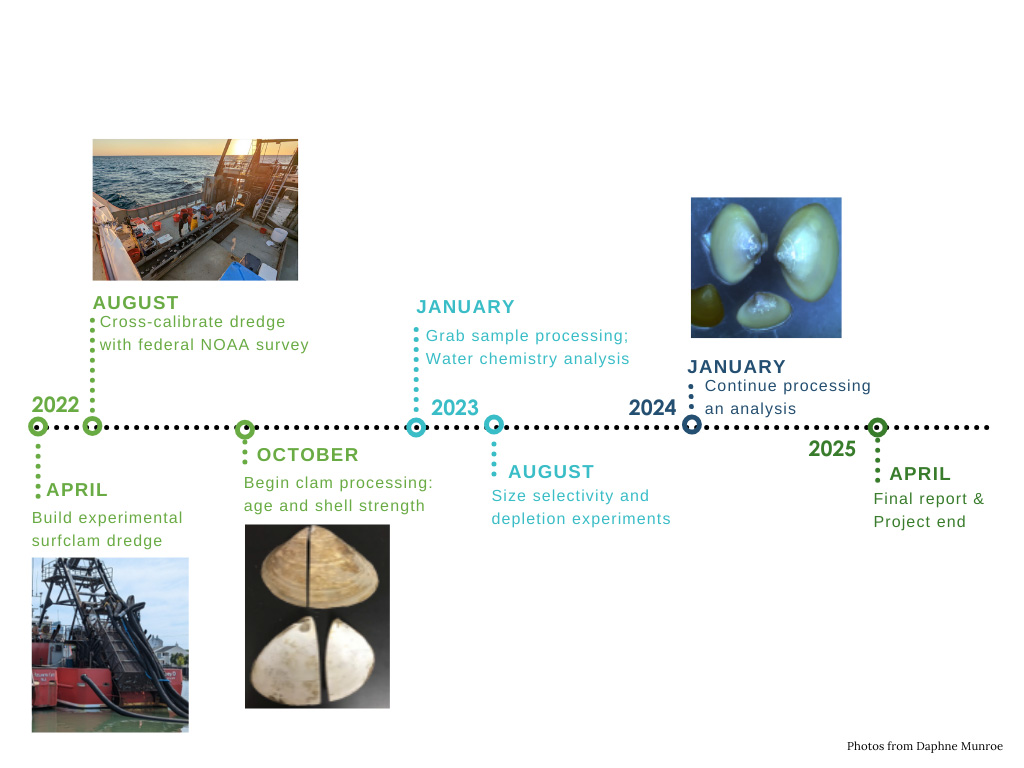
Explore more at the Haskin Shellfish Research Laboratory site.
Ongoing Projects
* Project proposals have been redacted to remove sensitive and proprietary information
Acoustic Telemetry
A collaboration between scientists from Monmouth university and the New England Aquarium will conduct cooperative research with a New Jersey commercial fisherman to tag and track a variety of fish species using acoustic telemetry. This project will complement an existing network of receivers to provide coverage in and around New Jersey wind energy areas (lease areas and export cable routes) and areas of biological significance (i.e., migration corridors). Acoustic telemetry has become an increasingly important tool to study migration patterns, habitat use and preferences, mortality, and general population monitoring of fish. Unlike traditional surveys, sampling is non-extractive and provides continuous monitoring of tagged animals over time.
Acoustic Telemetry Proposal* Key Personnel CVs Project Fact Sheet

Explore more at the Monmouth University Urban Coast Institute site.
Aerial Whale Survey
The RMI has funded NOAA to expand its existing aerial surveys for north Atlantic Right Whales and other large cetaceans to fully survey waters off of New Jersey. This project conducted by the Northeast Fisheries Science Center will provide information to estimate seasonal habitat use, distribution, and abundance for whales. Through this project NOAA will collaborate with external partners, maintain communication and coordination between state and federal partners, and contribute to regional data needs by leveraging ongoing and existing research efforts throughout the Mid-Atlantic Bight (from NY to VA).
Aerial Whale Survey Proposal* Project Fact Sheet
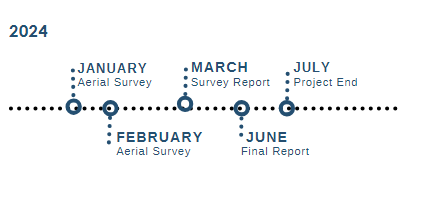
Cold Pool Stability
The RMI will collaborate with researchers at Rutgers University to evaluate the potential impacts of wind turbines on ocean mixing and the Mid-Atlantic Cold Pool. The first project objective is to evaluate the time scales required to break down ocean stratification by modeling the impacts of turbine foundation on fluid dynamics and turbulence, using steady-state and time-dependent analytical models (parameterized with data collected by the RMI ocean gliders). The second project objective is to investigate the potential impacts of turbine wind wakes on surface stress and water column stratification using models produced by Golbezi et al. (2022) and a custom Rutgers University Weather and Research Forecasting (RUWRF) model designed to capture the unique coastal upwelling found off coastal NJ.
Cold Pool Stability Proposal* Key Personnel CVs Project Fact Sheet

Explore more at the Rutgers University Center for Ocean Observing Leadership site.
Fish Community eDNA
A team from Monmouth University and St. Anselm College will partner with the commercial fishing industry to build on groundbreaking studies pairing environmental DNA (eDNA) with NJ Marine Resources monitoring surveys. This is the RMI’s third cooperative research project. Water samples will be collected in and around offshore wind energy areas to identify the species that recently inhabited those waters. These samples will be collected alongside New Jersey’s existing Ocean Trawl, Raritan Inventory, and NJ Artificial Reef survey, and in new, key locations to inform the use of non-extractive methods for fisheries science, mitigate potential impacts on surveys from offshore wind, and allow for a comparison of fish communities pre- and post-construction.
Environmental DNA Proposal* Key Personnel CVs Project Fact Sheet
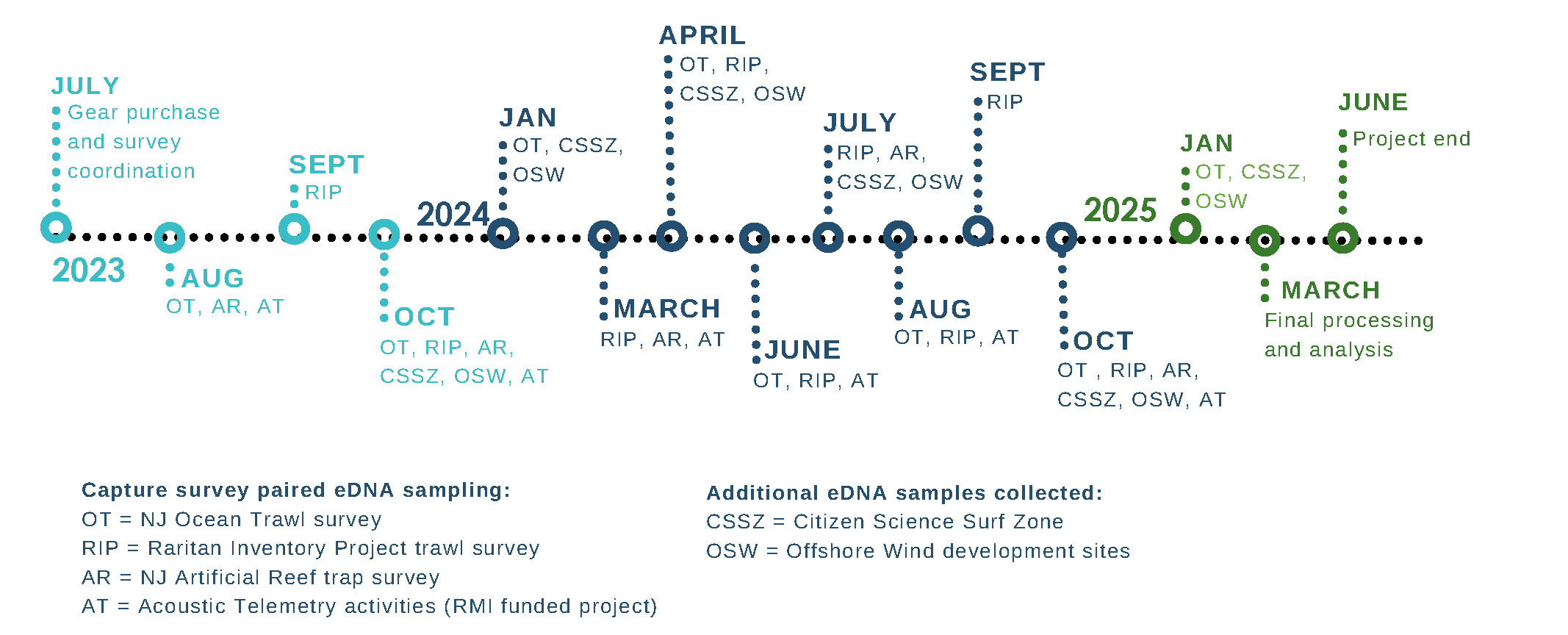
Explore more at the Monmouth University Urban Coast Institute site.
Glider Ecological Baseline
Ocean characteristics off of New Jersey’s coastline undergo significant variations on timescales of weeks, months and years. These variations drive changes in ocean ecosystems impacting the distribution, productivity, and diversity of marine organisms, including highly migratory fisheries and marine mammals. The RMI is funding this glider (autonomous under vehicles that navigate the ocean) program to characterize baseline environmental conditions and how they might impact the distribution of marine organisms. These data should help facilitate future efforts to assess the potential impacts offshore wind development and climate change.
Glider Proposal* Key Personnel CVs Project Fact Sheet
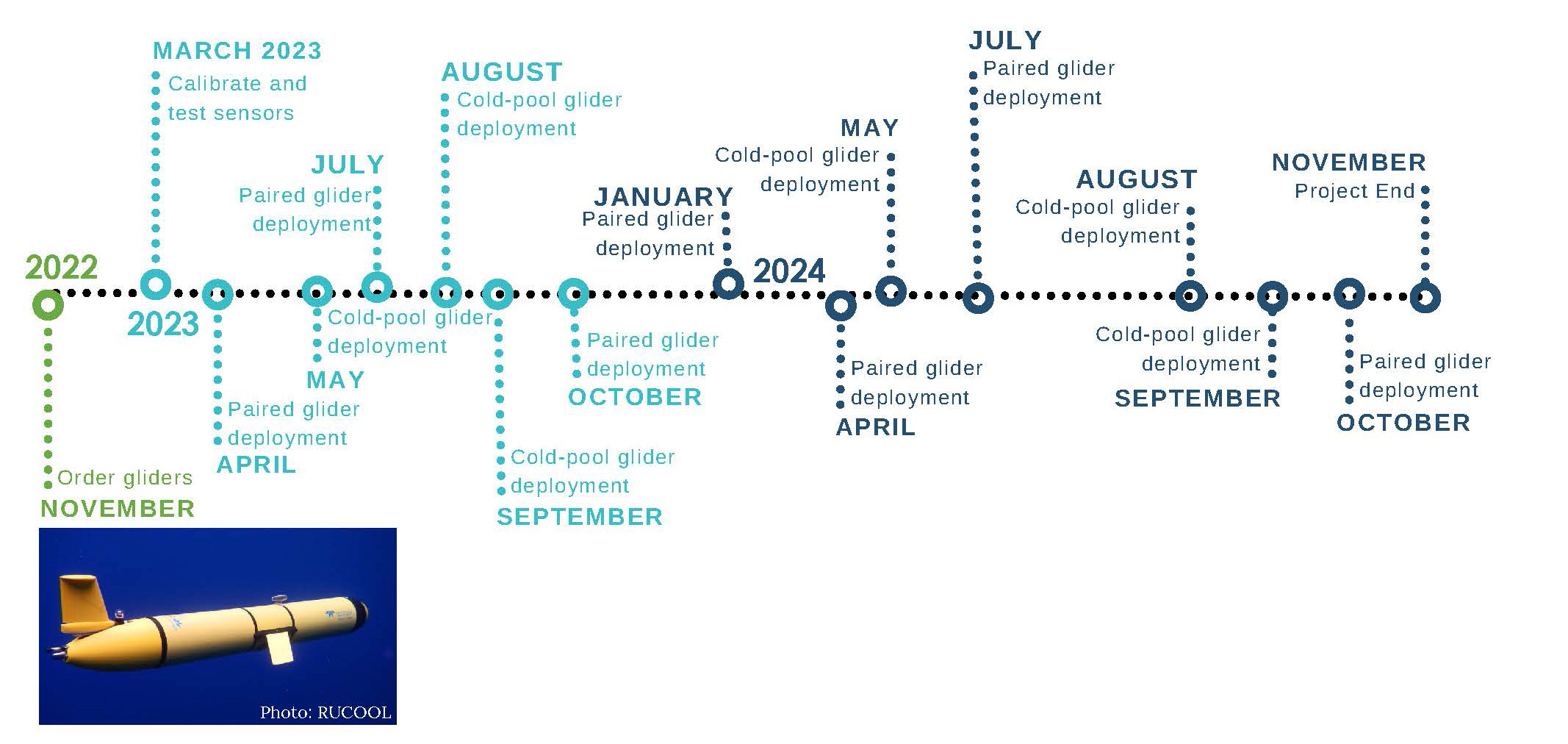
-
To see where Rutgers has current active glider deployments visit the Rutgers Active Glider Deployment webpage and follow RU39 and RU41. For records of previous deployments of the RMI gliders visit the Glider Deployments webpage.
Explore more at the Rutgers University Center for Ocean Observing Leadership site.
For live results of acoustic recordings of whale vocalizations please visit the WHOI Robots4Whales webpage and select Slocum Glider G3, Coastal New Jersey.
Harbor Seal Health and Movement
The RMI is providing funding for scientists at Stockton University and the Atlantic Marine Conservation Society to assess the health and better understand the movement patterns of New Jersey’s harbor seals. A robust population of harbor seals spends its winters hauled out in the Great Bay area of New Jersey, but very little is known about how those individuals use the offshore space where wind energy leases are planned. This study will also look at baseline health indicators of these key predators, such as stress hormones, to help us understand how they respond to future OSW-related activities, including construction and operation.
Harbor Seal Proposal* Key Personnel CVs Project Fact Sheet

Explore more at the Stockton University Marine Field Station site.
Motus Expansion for Birds and Bats
The RMI is providing funding to expand, and upgrade, the existing network of Motus Wildlife Tracking stations in New Jersey to support local and regional efforts assessing bird and bat movement, migration patterns, and risk associated with offshore wind area overlap. Terrestrial Motus stations will be deployed strategically along the shoreline and approximately East-West across the state, to maximize the probability of detecting tagged animals moving through the area. The East-West line of land-based stations will extend ~60 km offshore to the Atlantic Shores Bight lease area using ten ocean buoy-based Motus stations. This project will be led by researchers at the American Bird Conservancy in collaboration with researchers at the Biodiversity Research Institute, Willistown Conservation Trust/Northeast Motus Collaboration, and Ocean Tech Services.
Motus Expansion Proposal* Key Personnel CVs Project Fact Sheet
Near real-time Passive Acoustic Monitoring for whales
The RMI has awarded in funding to the Woods Hole Oceanographic Institute to deploy and maintain a whale detection buoy off the coast of Atlantic City, New Jersey. This award will be facilitated by the New Jersey Sea Grant Consortium. The buoy will listen for whales and detections will be reviewed and used to inform NOAA’s Slow Zones for Right Whales program to mitigate risks associated with vessel strikes and future construction noise. This project will also examine how to best use these data to inform management moving forward, including educating stakeholders on the capabilities of this technology, and fostering dialogue about how to implement near real-time acoustic monitoring into wind energy development activities.
Near Real-Time Passive Acoustic Monitoring Proposal* Key Personnel CVs Project Fact Sheet

Explore more at the Robots4Whales data site through the Woods Hole Oceanographic Institution.
Regional Monitoring Network
The RMI Steering Committee has approved funding to examine the potential use of offshore wind farm structures for remote environmental and ecological monitoring. As offshore wind develops across New Jersey’s outer continental shelf, infrastructure including turbines, foundations, and substations present a unique opportunity to establish long-term monitoring sites for collecting environmental and ecological data. A team of experts will engage relevant stakeholders to inform the development of recommendations for potential implementation at individual wind farms; as well as on a regional scale, to promote coordination of research and monitoring efforts. This work will be executed by experts from Rutgers University, Monmouth University, the National Renewable Energy Laboratory, and the Special Initiative on Offshore Wind.
Observing Guidance Proposal* Key Personnel CVs Project Fact Sheet

Passive Acoustic Monitoring
The RMI also anticipates releasing a request for proposals for a passive acoustic monitoring project to better understand the movements and behaviors of baleen whale species, including the endangered North Atlantic Right Whale, in the waters along New Jersey’s coastline. This project will be part of larger effort which includes collaboration with nearby state, regional, and federal entities that seeks to protect marine mammals as offshore wind farms are developed along the eastern seaboard.
ROSA
RWSC
Recreational Fishing Socioeconomics
On April 21, 2022, the New Jersey Research and Monitoring Initiative approved funding for Monitoring the Socioeconomic Impacts of New Jersey’s Offshore Wind Development on the Recreational Fisheries Economy, a proposal submitted by Dr. Pankaj Lal at Montclair University. Relatively little is known about the amount recreational anglers spend, what they spend money on, or how that spending could change in response to OSW development, but current estimates are that recreational fishing provides at least 15,000 jobs and adds $1.7 billion in sales, $0.7 billion in income, and $1.1 billion in value added to the State. This two year project will provide important pre-construction data needed to develop and implement methods to assess impact of OSW on recreational fisheries.
Socioeconomic Proposal* Key Personnel CVs Project Fact Sheet
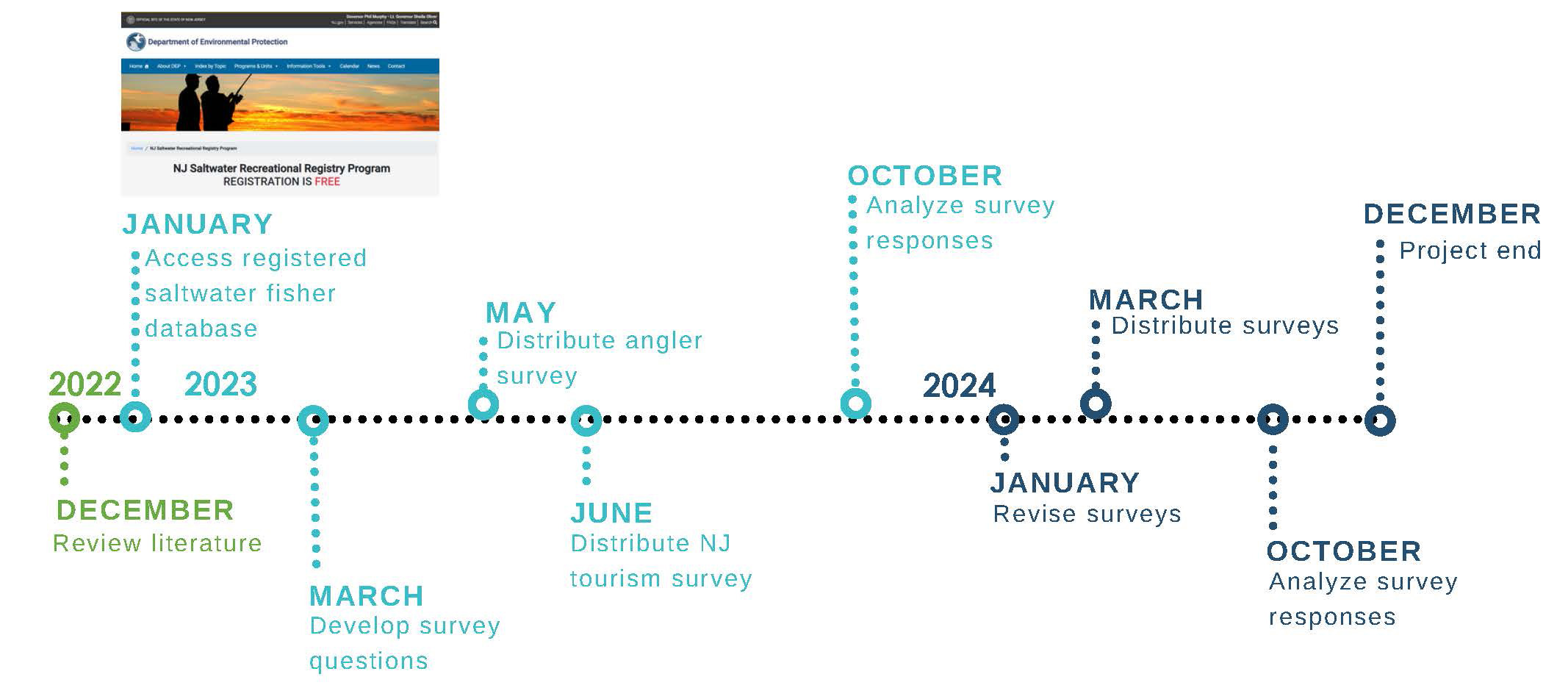
Sea Turtle Tagging and Health Assessment
Scientists from Coonamessett Farm Foundation (CFF), NOAA’s Northeast Fisheries Science Center, and Roger Williams University are collaborating to evaluate the ecology, movement, and biology of several hard-shelled sea turtle species in the MidAtlantic Bight. For two consecutive years, loggerhead, green, and kemps ridleys sea turtles will be tagged off NC and VA/MD as they migrate north and pass through New Jersey coastal waters and wind lease areas. Turtles will be outfitted with satellite and acoustic transmitters to monitor individual turtle movements, while also collecting oceanographic data to provide environmental context for movement and behavior. A suite of biological samples will also be collected to assess baseline, preconstruction blood chemistry (e.g., stress hormones), diet, and parasitic loads. Within the New Jersey lease areas video footage from camera tags and remotely operated vehicles (ROVs) will be used to characterize foraging behavior and prey preferences. Data from this study will be aggregated with previous telemetry and biological data collected by CFF to assess seasonal distribution and habitat use, stress levels, gut health, and prey preferences to inform potential impacts of offshore wind development.
Sea Turtle Tagging and Health Assessment Proposal* Key Personnel CVs Project Fact Sheet
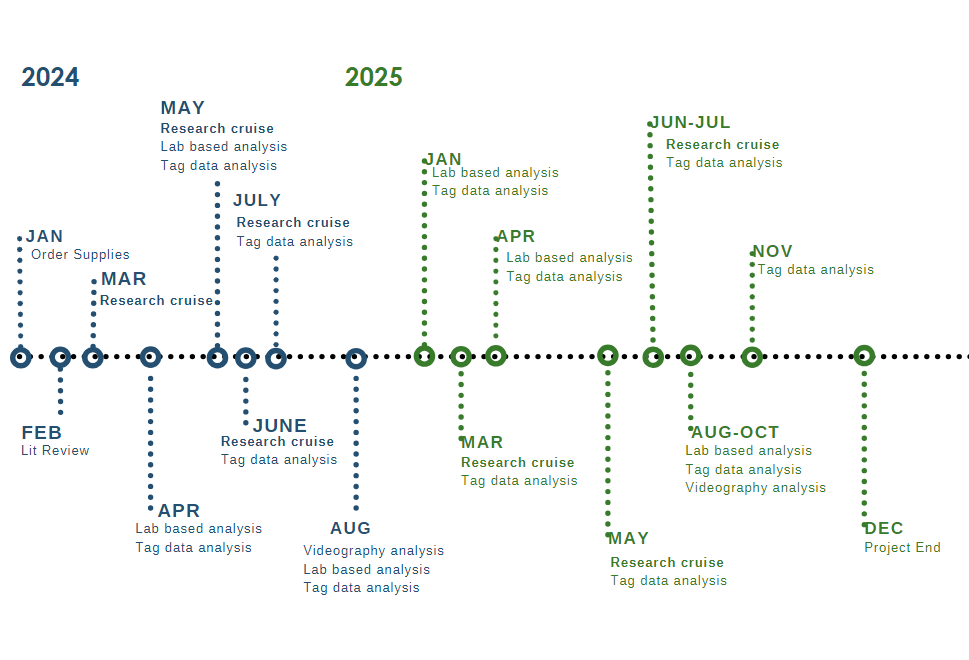
Explore more at the Coonamessett Farm Foundation site.
Surfclam Fishery Enhancement
RMI has approved funding for scientists at Rutgers University, in collaboration with Surfside Seafood Products and Research Vessel Explorer, to conduct experiments evaluating the growth and survival of hatchery-reared Atlantic surfclams. Offshore wind development is expected to impact surfclam fishery revenue in New Jersey, however, fishery enhancement may effectively mitigate industry losses through efforts to seed natural habitat with hatchery-raised juvenile clams. This practice has been successfully implemented in the US and by other nations for a variety of bivalve and finfish species but requires a better understanding the biological reference points for surfclam that inform fishery management and industry decisions. This study will explore how planting density of hatchery-reared juvenile surfclams (1 year old) affects the burial success, survival, and growth rate of clams in their natural habitat off the coast of Cape May. The project will also conduct lab-based experiments to evaluate the effects of seed density on the size preferences and feeding rate of two surfclam predators, the Moon Snail and Atlantic Rock Crab. The results of this project will help determine the viability and optimization of a potential surfclam enhancement program for New Jersey and the mid-Atlantic region.

Explore more at the Haskin Shellfish Research Laboratory site.
Whale Satellite Tagging
The RMI has awarded funding to researchers from Rutgers University and the University of Washington to track fin and humpback whales using satellite tags. Tracking data from this study will be used to evaluate regional movement, habitat use, and behavior (e.g., transiting versus foraging) of these whale species regularly observed in New Jersey waters. A primary goal of the study is to assess whale habitat overlap with current wind lease areas, cable transmission corridors, and shipping lanes. The study will also evaluate the connection between environmental parameters and habitat use or behavior, resulting in habitat forecasting models.
Whale Satellite Tagging Proposal* Key Personnel CVs Project Fact Sheet
News
-
RMI and New Jersey Sea Grant Consortium open Request for Proposals for several focus areas. – July 2024
-
Murphy Administration Announces Funding for Offshore Wind Research and Monitoring Initiative – March 2024
-
Request For Proposals: Passive Acoustic Monitoring for Cetaceans in the NY/NJ Bight
-
Request For Proposals: Expansion of NJ Motus Wildlife Tracking System for Birds and Bats
-
NJDEP Statement on East Coast Whale Mortalities – March 2023
-
Murphy Administration Marks Climate Week By Announcing Second Round Of Research Projects To Ensure Environmentally Responsible Offshore Wind Development – September 2022
To stay up to date, join the offshore wind mailing list.
If you have questions about offshore wind development in New Jersey.